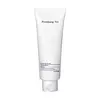What's inside
What's inside
 Benefits
Benefits

 Concerns
Concerns

 Ingredients Side-by-side
Ingredients Side-by-side

Water
Skin ConditioningPropanediol
SolventGlycerin
HumectantSodium Cocoamphoacetate
CleansingCoco-Betaine
CleansingDisodium Cocoyl Glutamate
CleansingDehydroxanthan Gum
Emulsion StabilisingRosa Damascena Flower Water
MaskingSodium Chloride
MaskingCitric Acid
BufferingSodium Cocoyl Glutamate
CleansingCaprylyl Glyceryl Ether
CleansingCaprylhydroxamic Acid
Leuconostoc/Radish Root Ferment Filtrate
Antimicrobial1,2-Hexanediol
Skin ConditioningAnanas Sativus Fruit Extract
Skin ConditioningWater, Propanediol, Glycerin, Sodium Cocoamphoacetate, Coco-Betaine, Disodium Cocoyl Glutamate, Dehydroxanthan Gum, Rosa Damascena Flower Water, Sodium Chloride, Citric Acid, Sodium Cocoyl Glutamate, Caprylyl Glyceryl Ether, Caprylhydroxamic Acid, Leuconostoc/Radish Root Ferment Filtrate, 1,2-Hexanediol, Ananas Sativus Fruit Extract
Saposhnikovia Divaricata Root Extract
AntimicrobialGlycerin
HumectantMyristic Acid
CleansingLauric Acid
CleansingPotassium Hydroxide
BufferingWater
Skin ConditioningPalmitic Acid
EmollientStearic Acid
CleansingGlycol Distearate
EmollientGlyceryl Stearate
EmollientGlyceryl Stearate Se
EmulsifyingPEG-100 Stearate
1,2-Hexanediol
Skin ConditioningButylene Glycol
HumectantGlyceryl Caprylate
EmollientOzokerite
Emulsion StabilisingHydrogenated Vegetable Oil
EmollientBeeswax
Emulsion StabilisingSodium Chloride
MaskingStearyl Stearate
EmollientHydrogenated Palm Acid
Capric Acid
CleansingOleic Acid
EmollientSodium Polyacrylate
AbsorbentCocamidopropyl Betaine
CleansingParfum
MaskingLinalool
PerfumingLimonene
PerfumingSaposhnikovia Divaricata Root Extract, Glycerin, Myristic Acid, Lauric Acid, Potassium Hydroxide, Water, Palmitic Acid, Stearic Acid, Glycol Distearate, Glyceryl Stearate, Glyceryl Stearate Se, PEG-100 Stearate, 1,2-Hexanediol, Butylene Glycol, Glyceryl Caprylate, Ozokerite, Hydrogenated Vegetable Oil, Beeswax, Sodium Chloride, Stearyl Stearate, Hydrogenated Palm Acid, Capric Acid, Oleic Acid, Sodium Polyacrylate, Cocamidopropyl Betaine, Parfum, Linalool, Limonene
 Reviews
Reviews

Ingredients Explained
These ingredients are found in both products.
Ingredients higher up in an ingredient list are typically present in a larger amount.
1,2-Hexanediol is a synthetic liquid and another multi-functional powerhouse.
It is a:
- Humectant, drawing moisture into the skin
- Emollient, helping to soften skin
- Solvent, dispersing and stabilizing formulas
- Preservative booster, enhancing the antimicrobial activity of other preservatives
Glycerin is already naturally found in your skin. It helps moisturize and protect your skin.
A study from 2016 found glycerin to be more effective as a humectant than AHAs and hyaluronic acid.
As a humectant, it helps the skin stay hydrated by pulling moisture to your skin. The low molecular weight of glycerin allows it to pull moisture into the deeper layers of your skin.
Hydrated skin improves your skin barrier; Your skin barrier helps protect against irritants and bacteria.
Glycerin has also been found to have antimicrobial and antiviral properties. Due to these properties, glycerin is often used in wound and burn treatments.
In cosmetics, glycerin is usually derived from plants such as soybean or palm. However, it can also be sourced from animals, such as tallow or animal fat.
This ingredient is organic, colorless, odorless, and non-toxic.
Glycerin is the name for this ingredient in American English. British English uses Glycerol/Glycerine.
Learn more about GlycerinChances are, you eat sodium chloride every day. Sodium Chloride is also known as table salt.
This ingredient has many purposes in skincare: thickener, emulsifier, and exfoliator.
You'll most likely find this ingredient in cleansers where it is used to create a gel-like texture. As an emulsifier, it also prevents ingredients from separating.
There is much debate on whether this ingredient is comedogenic. The short answer - comedogenic ratings don't tell the whole story. Learn more about comegodenic ratings here.
The concensus about this ingredient causing acne seems to be divided. Research is needed to understand if this ingredient does cause acne.
Scrubs may use salt as the primary exfoliating ingredient.
Learn more about Sodium ChlorideWater. It's the most common cosmetic ingredient of all. You'll usually see it at the top of ingredient lists, meaning that it makes up the largest part of the product.
So why is it so popular? Water most often acts as a solvent - this means that it helps dissolve other ingredients into the formulation.
You'll also recognize water as that liquid we all need to stay alive. If you see this, drink a glass of water. Stay hydrated!
Learn more about Water